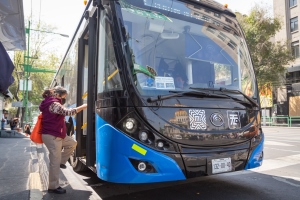In 2017, WhereIsMyTransport set about mapping the unmapped public transport networks in South Africa something nobody had ever done at scale. In the years since, we have built a reputation as the global provider of mapping public transport networks and their environments in more than 40 emerging-market cities in 27 countries, says Julian Hirst, chief growth officer, and Jenny Puyo, head of data production, at WhereIsMyTransport
Today, when clients point us at a new city, we go from zero to fully maintained data sets in weeks, guaranteeing coverage, completeness, and quality. Five years ago, when we started in Cape Town, we had no experience, no tools, and no model for how to do what we were about to do.
The emerging-market mobility challenge
Public transport users in the developed world take information for granted: stations, stops, and supporting infrastructure are signposted, timetables and maps are reliable and freely available, tickets and fares make sense. In the Majority World, where two thirds of the urban population rely on public transport to get around, information is incomplete, unreliable, and not available from a single source if at all.
Even established transport agencies don’t keep information updated. In Dhaka and Johannesburg, for example, paper timetables at stations are more likely to be accurate than information on agency websites. Our Data Lead in Hyderabad regularly hears stories of people missing flights, appointments, interviews and worse because of out-of-date schedules.
Billions of people in emerging markets rely on personal experience, knowledge shared by family and friends, and signals ‘hidden’ in the urban landscape to figure out how to move around. When we began mapping South Africa, we picked this up quickly, and saw an opportunity to build a centralised database that includes complete mobility and location data for these high-growth markets.
Making the invisible visible
If you can’t see something and if you don’t even know it’s there how do you find it and map it?
In an emerging-market megacity, alongside formal, state-run public transport, there may be tens of thousands of informally run vehicles, owned by hundreds of independent operators, moving millions of people on thousands of routes. Most routes are dynamic, changing from one trip to the next. To map them, you have to know where they are, where they begin and end, and how they operate. Once you start identifying them, you have to be sure you’ve got them all. And to collect information detailed enough to build something valuable, you need local people on the ground. Before WhereIsMyTransport, no-one had done this.
1. People
Capturing the complete picture of mobility and place in emerging markets cannot be done with technology alone. If you want high-quality data that represents the ‘ground truth’, you need local boots on the ground. In Hanoi and Bangkok, commuters use river ferry crossings to shorten journeys. One such crossing is shared between neighbouring villages, with the location of its starting point alternating between villages depending on the day of the month among other things. These operational quirks are common in all the cities where we work. To ensure our data reflects them, we recruit and train local people to map the city.
2. Product suite for data management
When we started out, there were a handful of data collection apps and tools for formal transit data. The global-standard format for transit data is the General Transit Feed Specification, or GTFS, but formal transit data doesn’t behave the same way as informal transit data, and we needed to manage and edit both. Nobody had developed an end-to-end product suite that could capture, validate, process, and create a single GTFS feed that includes formal and informal transit data. So we developed one ourselves.
With every new city, and every new client, we enhanced our product suite for example, using AI and machine learning to automate tasks and control data quality. Today, our fully customisable mobile app Collector enables us to map formal and informal transit networks, and to collect the added contextual data that we need to decode network operations.
3. Playbook
The knowledge and experience we’ve accumulated with every city mapped, and the improvements we’ve built into our data management product suite, all roll up into our data production playbook. Our playbook gives us a powerful advantage. Two years ago, for example, it enabled us to sidestep many of the blockers that threatened to slow us down when COVID began to spread. We reconfigured our process and products to map cities remotely no travel required.
Our playbook allows us to accelerate the roll-out of new features and processes, and to operationalise for scale mapping multiple megacities simultaneously, stacking multiple data types, and acquiring new markets more quickly and efficiently. In 2017, we mapped Cape Town (population 4.5M) in six months, with a handful of data collectors. In 2019, we mapped Mexico City (population 21.2M) in just six weeks, with a ‘coordinated crowd’ of 60 data collectors.
Opportunities in innovation
In the future, increasing automation will mean smarter systems taking on complex tasks done manually today. Technologies can support in anticipating mapping and maintenance needs, with improved modelling and predictions enabling our teams to identify areas with the greatest likelihood of change, leading to more targeted interventions. Our Data Engineers constantly improve the predictive models we use to support faster, more accurate mapping, driving down the cost of market acquisition and maintenance. All of which means that we can scale more quickly, mapping not just cities but whole countries.
Collaborating with local Data Leads to decode movement and place, our research division analyses behaviours reflected in our data offering, as well as in knowledge products that provide insights into how cities move. Our local Data Leads build trusted relationships with organisations and communities. We deepen our integration into mobility ecosystems through partnerships and importantly by crowdsourcing data from commuters using our Android app Rumbo in Mexico City, Lima, and Bangkok.
Today, app users can contribute information about anything from route data to service disruptions. This is a powerful and popular feature for the community, and looks set to significantly reduce the cost of data maintenance mobilising ‘mappers’ who benefit from a value exchange that works very much in their favour. Tapping into existing knowledge rather than creating data from scratch engages citizens in data creation, helping us build comprehensive and accurate data assets for cities.
Majority world in motion
Most of the world’s fastest-growing cities are in emerging markets, where billions of people rely on public transport to move around. The economic, cultural, political, and social health of these cities depend on mobility.

The rapid increase in mobile phone penetration and internet adoption already affords leading multinationals greater access and opportunity as they look to high-growth emerging markets for their next users. Those opportunities for growth will be more accessible than ever, with anyone looking to make data-driven investments having access to the information they need to understand movement and place. It’s excellent news for the mobility sector, too: infostructure is every bit as important as infrastructure to the future of mobility.
The work we do at WhereIsMyTransport is key to this. Only by decoding emerging markets can we accelerate the development of solutions to support cities and citizens, and in turn further accelerate growth across the Majority World.
The authors are Julian Hirst, chief growth officer, and Jenny Puyo, head of data production, at WhereIsMyTransport.
Comment on this article below or via Twitter: @IoTNow_OR @jcIoTnow










